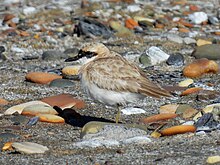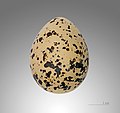Greater sand plover
| Greater sand plover | |
|---|---|

| |
| Nominate A. l. leschenaultii in breeding plumage; a vagrant in Northumberland, UK | |
| Scientific classification | |
| Domain: | Eukaryota |
| Kingdom: | Animalia |
| Phylum: | Chordata |
| Class: | Aves |
| Order: | Charadriiformes |
| Family: | Charadriidae |
| Genus: | Anarhynchus |
| Species: | A. leschenaultii
|
| Binomial name | |
| Anarhynchus leschenaultii (Lesson, 1826)
| |
| Synonyms | |
|
Charadrius leschenaultii (protonym) | |
The greater sand plover (Anarhynchus leschenaultii) is a small wader in the plover family of birds. The spelling is often given as "greater sandplover" or "greater sand-plover", but the official IOC and British Ornithologists' Union spelling is "Greater Sand Plover".[2][3] The specific leschenaultii commemorates the French botanist Jean Baptiste Leschenault de la Tour.[4] Like most other species in the genus Anarhynchus, it was until recently included in the genus Charadrius.[2]
Distribution
[edit]It breeds in the semi-deserts of Turkey and eastwards through Central Asia, where it nests in a bare ground scrape. This species is strongly migratory, wintering on sandy beaches in East Africa, South Asia and Australasia. It is a rare vagrant in western Europe, where it has been recorded as far west as Iceland. It has been recorded twice in North America, the most recent being on 14 May 2009 in Jacksonville, Florida.[5]
Subspecies
[edit]There are three subspecies:[2][6][7]
- A. l. leschenaultii, the nominate, in the east of the species' range in Mongolia and NW China. Bill intermediate; summer plumage with a weak orange breast band.
- A. l. scythicus, in the centre of the species' range in Central Asia. Bill largest in the species; summer plumage with a moderate orange breast band. Syn. A. l. crassirostris; this name is however preoccupied by a subspecies of Wilson's plover, A. wilsonia crassirostris described 48 years earlier.[7]
- A. l. columbinus, in the west of the species' range in SW Asia west to central Turkey. Bill smallest in the species; summer plumage with a strong orange breast band.
Description
[edit]This chunky plover is 19–22 cm long, slightly larger than a common ringed plover, and is conspicuously long-legged and thick-billed. Breeding males have sandy buff backs and white underparts. The breast, forehead and nape are variably orange in summer, and there is a black eye mask in summer. The female is duller and greyer, and winter and juvenile birds are browner, apart from a hint of rufous on the head. The legs are greenish-yellow and the bill black.[6]
In all plumages, it is very similar to its close relatives Siberian sand plover A. mongolus and Tibetan sand plover A. atrifrons. Separating the species may be straightforward in mixed wintering flocks on an Indian beach, where the difference in size and structure is obvious; it is another thing altogether to identify a lone vagrant to western Europe, where both species are very rare. The problem is compounded in that the southwest Asian subspecies of the greater is the most similar to the other two species in its smaller bill.
Ecology
[edit]Its food consists of insects, crustaceans and annelid worms, which are obtained by a run-and-pause technique, rather than the steady probing of some other wader groups.[citation needed]
Its flight call is a soft trill.[citation needed]
The greater sand plover is one of the species to which the Agreement on the Conservation of African-Eurasian Migratory Waterbirds (AEWA) applies.[citation needed]
Gallery
[edit]-
Winter plumage, Darwin, Northern Territory, Australia
-
Feeding, at Kutch, India
-
In flight; Kutch, India
-
Wynnum Esplanade, SE Queensland, Australia
-
Egg - MHNT
References
[edit]- ^ BirdLife International (2019). "Charadrius leschenaultii". IUCN Red List of Threatened Species. 2019: e.T22693862A153879900. doi:10.2305/IUCN.UK.2019-3.RLTS.T22693862A153879900.en. Retrieved 13 November 2021.
- ^ a b c Gill, Frank; Donsker, David; Rasmussen, Pamela, eds. (January 2024). "Buttonquail, thick-knees, sheathbills, plovers, oystercatchers, stilts, painted-snipes, jacanas, Plains-wanderer, seedsnipes". IOC World Bird List Version 14.1. International Ornithologists' Union. Retrieved 26 July 2024.
- ^ "Charadrius leschenaultii". Avibase.
- ^ Jobling, James A (2010). The Helm Dictionary of Scientific Bird Names. London: Christopher Helm. pp. 99, 222. ISBN 978-1-4081-2501-4.
- ^ "From Asia by air, rare bird visits Huguenot". Times-Union, Florida. Jacksonville.com. 15 May 2009. Retrieved 17 May 2009.
- ^ a b Svensson, L., Mullarney, K., & Zetterström, D. (2009) Collins Bird Guide, ed. 2. ISBN 0-00-219728-6, pages 144-145
- ^ a b Carlos, C. J., S. Roselaar, & J-F. Voisin (2012). A replacement name for Charadrius leschenaultii crassirostris (Severtzov, 1873), a subspecies of Greater Sand Plover. Bulletin of the British Ornithologists' Club 132 (1): 63–65.
Further reading
[edit]- Taylor, P.B. (1987) Field identification of Greater and Lesser Sandplovers, pp. 15–20 in International Bird Identification: Proceedings of the 4th International Identification Meeting, Eilat, 1st - 8th November 1986 International Birdwatching Centre Eilat
External links
[edit]- Greater sand plover - Species text in The Atlas of Southern African Birds.





